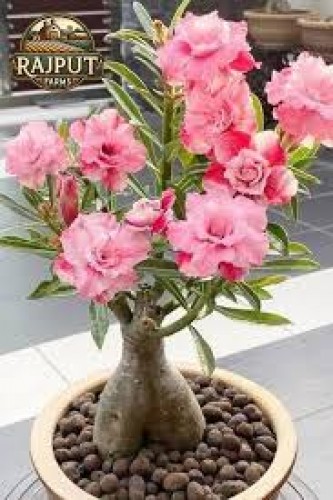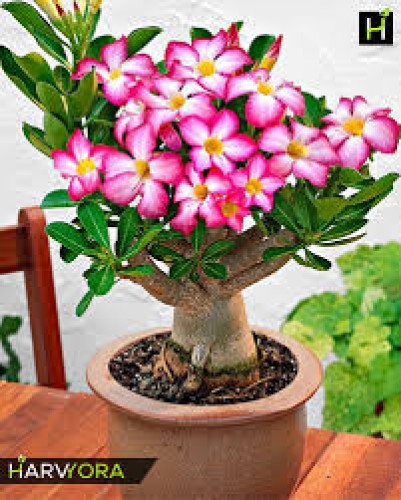off
-
Sold
-

-

out
Adenium Plant: Overview, Care, Uses, and Advantages
Overview
Adenium, commonly known as the Desert Rose, is a striking succulent plant native to tropical and subtropical regions of Africa and the Arabian Peninsula. Known for its beautiful, trumpet-shaped flowers and thick, swollen trunk, Adenium is a popular ornamental plant often grown in gardens or as a potted plant.
Care of Adenium
1. Light:
Adenium thrives in bright, direct sunlight. It requires at least 6 hours of sunlight each day to maintain its health and produce vibrant flowers. If grown indoors, place it near a south-facing window where it can get sufficient sunlight.
2. Watering:
As a drought-tolerant succulent, Adenium doesn't require frequent watering. Water the plant thoroughly, allowing the soil to dry completely between waterings. Overwatering can lead to root rot. During the winter months, reduce watering as the plant goes into a dormant period.
3. Soil:
Adenium prefers well-draining soil. A cactus or succulent mix is ideal. You can also add sand or perlite to regular potting soil to improve drainage.
4. Temperature:
This plant thrives in warm temperatures, ideally between 70-100°F (21-38°C). Avoid temperatures below 50°F (10°C) as they can damage the plant.
5. Fertilizing:
Feed the plant with a balanced, water-soluble fertilizer once every 4-6 weeks during the growing season (spring and summer). Avoid fertilizing in the fall and winter when the plant is dormant.
6. Pruning:
Prune dead or damaged stems to encourage healthy growth and maintain a compact shape. If you want to control its size, prune back new growth.
Uses of Adenium
1. Ornamental Plant:
Adenium is widely used as an ornamental plant due to its striking flowers in shades of pink, red, and white, often with a contrasting darker center. It is a favorite in both gardens and as a houseplant, adding a tropical, exotic flair to any space.
2. Medicinal Uses (Traditional):
In traditional medicine, various parts of the Adenium plant have been used in some cultures for their purported therapeutic properties. However, caution is advised, as the plant is toxic if consumed.
3. Landscape Design:
It is often used in xeriscaping (drought-tolerant landscaping) due to its minimal water requirements and dramatic appearance. Adenium can also be used as a bonsai, thanks to its thick trunk and unique shape.
Advantages of Adenium
1. Low Maintenance:
Adenium is relatively easy to care for, requiring minimal attention compared to many other plants. Its ability to thrive in dry conditions makes it ideal for those with less time for frequent plant care.
2. Attractive Aesthetic Appeal:
The plant's striking flowers and unique form make it a decorative centerpiece for homes, patios, and gardens.
3. Drought Resistance:
As a succulent, Adenium is highly drought-resistant, making it an excellent choice for regions with water shortages or for gardeners looking for low-water plants.
4. Air Purification:
Like many plants, Adenium can contribute to improving air quality by absorbing carbon dioxide and releasing oxygen, making it beneficial for indoor spaces.
5. Longevity:
With proper care, Adenium can live for many years, providing long-term beauty and enjoyment.
Conclusion
Adenium is a visually stunning and easy-to-care-for plant, perfect for gardeners of all levels. Its unique appearance, drought tolerance, and low maintenance needs make it an ideal choice for both indoor and outdoor spaces. Whether used as an ornamental feature, in landscape design, or even in traditional medicine (with caution), Adenium offers numerous advantages, making it a beloved plant worldwide.